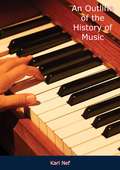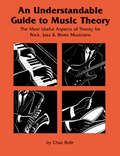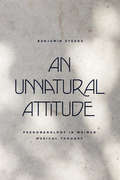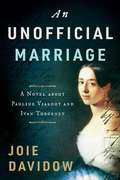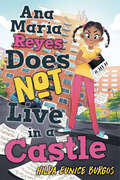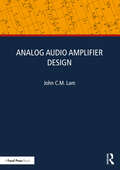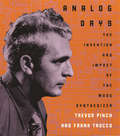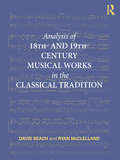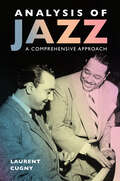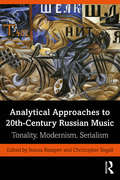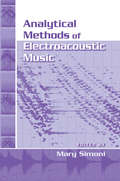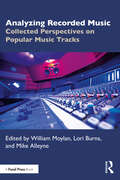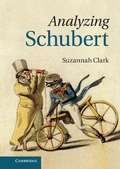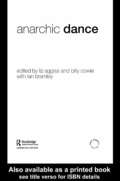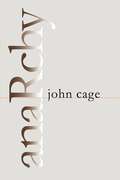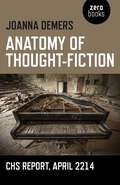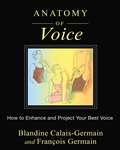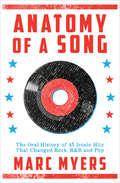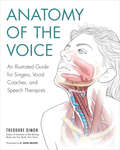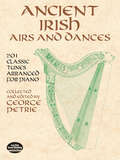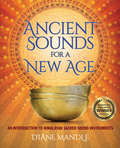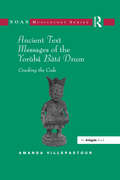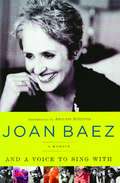- Table View
- List View
An Outline of the History of Music
by Karl NefThis series inaugurated by the Columbia University Press is intended to meet the needs of the English-speaking student for the crystallization of various phases of musical knowledge around which the rapidly expanding material may be oriented. The choice of the 1st volume of the series was dictated by the desire to provide an introductory manual which would be of interest to the beginner in musical history, since a scholarly view of the development of the art must be the foundation of scholarly research into special problems. The Outline of the History of Music by the late Professor Nef of Basle is such a work. It was written by a trained musicologist of broad tastes, who was reliable in his judgements concerning recent developments in musical history and also of its early phases.
An Understdable Guide to Music Theory: The Most Useful Aspects of Theory for Rock, Jazz, and Blues Musicians
by Chaz BufeThis guide explains the most useful aspects of theory in clear, nontechnical language. Areas covered include scales (major, minor, modal, synthetic), chord formation, chord progression, melody, song forms, useful devices, (ostinato, mirrors, hocket, etc.), and instrumentation. It contains over 100 musical examples.
An Unnatural Attitude: Phenomenology in Weimar Musical Thought (New Material Histories of Music)
by Benjamin SteegeAn Unnatural Attitude traces a style of musical thought that coalesced in the intellectual milieu of the Weimar Republic—a phenomenological style that sought to renew contact with music as a worldly circumstance. Deeply critical of the influence of naturalism in aesthetics and ethics, proponents of this new style argued for the description of music as something accessible neither through introspection nor through experimental research, but rather in an attitude of outward, open orientation toward the world. With this approach, music acquires meaning in particular when the act of listening is understood to be shared with others. Benjamin Steege interprets this discourse as the response of a young, post–World War I generation amid a virtually uninterrupted experience of war, actual or imminent—a cohort for whom disenchantment with scientific achievement was to be answered by reasserting the value of imaginative thought. Steege draws on a wide range of published and unpublished texts from music theory, pedagogy, criticism, and philosophy of music, some of which appear for the first time in English translation in the book’s appendixes. An Unnatural Attitude considers the question: What are we thinking about when we think about music in non-naturalistic terms?
An Unofficial Marriage: A Novel about Pauline Viardot and Ivan Turgenev
by Joie DavidowFor Fans of Alexander Chee's best-selling novel, The Queen of the Night and opera fans everywhere. Set against the backdrop of the tumultuous events of 19th century Europe, An Unofficial Marriage dramatizes the equally tumultuous real-life love affair of two great artists—the famous Russian author, Ivan Turgenev, and the celebrated French opera singer, Pauline Viardot. From the moment he encounters her on the St. Petersburg stage, Ivan falls completely for Pauline. Though Pauline returns his feelings, she is bound by her singular passion for her art and her devotion to her gentle, older husband, Louis. Nevertheless, Ivan pursues Pauline across countries and continents—from Russia to France to Germany to Prussia—and in the decades that follow their fateful meeting, the lives of Pauline, Ivan, and Louis remain permanently intertwined as the lovers face jealousy, separation, the French Revolution of 1848, the cholera epidemic of 1849, the Franco-Prussian War, Turgenev&’s arrest in Russia, Louis&’s heartbreak and resignation, and the highs and lows of their artistic careers. &“You know those unofficial marriages,&” Turgenev would write almost thirty years after meeting Pauline, &“They sometimes turn out more poisonous than the accepted form.&” With beautiful and compelling prose and employing multiple perspectives, Joie Davidow (who herself has a background in opera) illuminates not only the interior lives of these two intensely passionate artists, but also the grand historic moments that Pauline and Ivan experienced and the celebrated figures who moved in their circles—including George Sand, Leo Tolstoy, Frédéric Chopin, Franz Liszt, and Ary Scheffer—providing insight into the dynamic worlds of 19th century opera, literature, art, and politics. Epic in the tradition of the Russian writers whom we encounter, and as romantic and tragic as the operas that Pauline Viardot performs in, An Unofficial Marriage brings to life with great scope and great humanity this captivating story from the past and explores timeless questions about the relationship between art and passion and the complex workings of the human heart.
Ana Maria Reyes Does Not Live in a Castle
by Hilda BurgosNotable Children's Book, Association for Library Service to Children (ALSC) Choices, Cooperative Children's Book Center (CCBC)The Penderwicks meets In the Heights in this sparkling middle-grade debut about a young Dominican American girl in New York City.Her last name may mean "kings," but Ana María Reyes REALLY does not live in a castle. Rather, she's stuck in a tiny apartment with two parents (way too lovey-dovey), three sisters (way too dramatic), everyone's friends (way too often), and a piano (which she never gets to practice). And when her parents announce a new baby is coming, that means they'll have even less time for Ana María. <p><p> Then she hears about the Eleanor School, New York City's best private academy. If Ana María can win a scholarship, she'll be able to get out of her Washington Heights neighborhood school and achieve the education she's longed for. To stand out, she'll need to nail her piano piece at the upcoming city showcase, which means she has to practice through her sisters' hijinks, the neighbors' visits, a family trip to the Dominican Republic... right up until the baby's birth! But some new friends and honest conversations help her figure out what truly matters, and know that she can succeed no matter what. Ana María Reyes may not be royal, but she's certain to come out on top.
Analog Audio Amplifier Design
by John C.M. LamAnalog Audio Amplifier Design introduces all the fundamental principles of analog audio amplifiers, alongside practical circuit design techniques and advanced topics. Covering all the basics of amplifier operation and configuration, as well as high-end audio amplifiers, this is a comprehensive guide with design examples and exercises throughout. With chapters on single-device, operational, multi-stage, voltage buffer, power, line-stage and phono-stage amplifiers, Analog Audio Amplifier Design is a comprehensive and practical introduction that empowers readers to master a range of design techniques. This book also provides a variety of graphs and tables of key amplifying devices and properties of amplifier configurations for easy reference. This is an essential resource for audio professionals and hobbyists interested in audio electronics and audio engineering, as well as students on electrical and audio engineering courses.
Analog Days: The Invention and Impact of the Moog Synthesizer
by Trevor Pinch Frank TroccoThough ubiquitous today, available as a single microchip and found in any electronic device requiring sound, the synthesizer when it first appeared was truly revolutionary. Something radically new--an extraordinary rarity in musical culture--it was an instrument that used a genuinely new source of sound: electronics. How this came to be--how an engineering student at Cornell and an avant-garde musician working out of a storefront in California set this revolution in motion--is the story told for the first time in Analog Days, a book that explores the invention of the synthesizer and its impact on popular culture. The authors take us back to the heady days of the 1960s and early 1970s, when the technology was analog, the synthesizer was an experimental instrument, and synthesizer concerts could and did turn into happenings. Interviews with the pioneers who determined what the synthesizer would be and how it would be used--from inventors Robert Moog and Don Buchla to musicians like Brian Eno, Pete Townshend, and Keith Emerson--recapture their visions of the future of electronic music and a new world of sound. Tracing the development of the Moog synthesizer from its initial conception to its ascension to stardom in Switched-On Bach, from its contribution to the San Francisco psychedelic sound, to its wholesale adoption by the worlds of film and advertising, Analog Days conveys the excitement, uncertainties, and unexpected consequences of a new technology that would provide the soundtrack for a critical chapter of our cultural history.
Analysis of 18th- and 19th-Century Musical Works in the Classical Tradition
by David Beach Ryan McClellandAnalysis of 18th- and 19th-Century Musical Works in the Classical Tradition is a textbook for upper-level undergraduate and graduate courses in music analysis. It outlines a process of analyzing works in the Classical tradition by uncovering the construction of a piece of music—the formal, harmonic, rhythmic, and voice-leading organizations—as well as its unique features. It develops an in-depth approach that is applied to works by composers including Haydn, Mozart, Beethoven, Schubert, Schumann, and Brahms. The book begins with foundational chapters in music theory, starting with basic diatonic harmony and progressing rapidly to more advanced topics, such as phrase design, phrase expansion, and chromatic harmony. The second part contains analyses of complete musical works and movements. The text features over 150 musical examples, including numerous complete annotated scores. Suggested assignments at the end of each chapter guide students in their own musical analysis.
Analysis of Jazz: A Comprehensive Approach (American Made Music Series)
by Laurent CugnyAnalysis of Jazz: A Comprehensive Approach, originally published in French as Analyser le jazz, is available here in English for the first time. In this groundbreaking volume, Laurent Cugny examines and connects the theoretical and methodological processes that underlie all of jazz. Jazz in all its forms has been researched and analyzed by performers, scholars, and critics, and Analysis of Jazz is required reading for any serious study of jazz; but not just musicians and musicologists analyze jazz. All listeners are analysts to some extent. Listening is an active process; it may not involve questioning but it always involves remembering, comparing, and listening again. This book is for anyone who attentively listens to and wants to understand jazz. Divided into three parts, the book focuses on the work of jazz, analytical parameters, and analysis. In part one, Cugny aims at defining what a jazz work is precisely, offering suggestions based on the main features of definition and structure. Part two he dedicates to the analytical parameters of jazz in which a work is performed: harmony, rhythm, form, sound, and melody. Part three takes up the analysis of jazz itself, its history, issues of transcription, and the nature of improvised solos. In conclusion, Cugny addresses the issues of interpretation to reflect on the goals of analysis with regard to understanding the history of jazz and the different cultural backgrounds in which it takes place. Analysis of Jazz presents a detailed inventory of theoretical tools and issues necessary for understanding jazz.
Analytical Approaches to 20th-Century Russian Music: Tonality, Modernism, Serialism
by Inessa Bazayev Christopher SegallThis volume brings together analyses of works by thirteen Russian composers from across the twentieth century, showing how their approaches to tonality, modernism, and serialism forge forward-looking paths independent from their Western counterparts. Russian music of this era is widely performed, and much research has situated this repertoire in its historical and social context, yet few analytical studies have explored the technical aspects of these composers' styles. With a set of representative analyses by leading scholars in music theory and analysis, this book for the first time identifies large-scale compositional trends in Russian music since 1900.The chapters progress by compositional style through the century, and each addresses a single work by a different composer, covering pieces by Rachmaninoff, Myaskovsky, Prokofiev, Shostakovich, Mansurian, Roslavets, Mosolov, Lourié, Tcherepnin, Ustvolskaya, Denisov, Gubaidulina, and Schnittke. Musicians, scholars, and students will find here a starting point for research and analysis of these composers' works and gain a richer understanding of how to listen to and interpret their music.
Analytical Methods of Electroacoustic Music
by Mary SimoniContaining extensive artwork serving as demonstration, as well as a DVD with sound and video clips, this collection of essays on electroacoustic music explores the creative possibilities to be found in various forms of musical analysis. Taking pitch, duration, intensity, and timbre as the four basic elements of music, the authors discuss electroacoustic works and examine: * the applications of neumes* contemporary staff notation* sound orchestra and score files* time-domain representations* spectrograms. Taking into consideration both the positive aspects (preservation of the abstract) and negative aspects (creative limitation) of these analytical methods, the authors have created a useful resource for students of electroacoustic music.
Analyzing Recorded Music: Collected Perspectives on Popular Music Tracks
by Lori Burns William Moylan Mike AlleyneAnalyzing Recorded Music: Collected Perspectives on Popular Music Tracks is a collection of essays dedicated to the study of recorded popular music, with the aim of exploring "how the record shapes the song" (Moylan, Recording Analysis, 2020) from a variety of perspectives. Introduced with a Foreword by Paul Théberge, the distinguished editorial team has brought together a group of reputable international contributors to write about a rich collection of recordings. Examining a diverse set of songs from a range of genres and points in history (spanning the years 1936–2020), the authors herein illuminate unique attributes of the selected tracks and reveal how the recording develops the expressive content of song performance. Analyzing Recorded Music will interest all those who study popular music, cultural studies, and the musicology of record production, as well as to popular music listeners.
Analyzing Schubert
by Suzannah ClarkWhen Schubert's contemporary reviewers first heard his modulations, they famously claimed that they were excessive, odd and unplanned. This book argues that these claims have haunted the analysis of Schubert's harmony ever since, outlining why Schubert's music occupies a curiously marginal position in the history of music theory. Analyzing Schubert traces how critics, analysts and historians from the early nineteenth century to the present day have preserved cherished narratives of wandering, alienation, memory and trance by emphasizing the mystical rather than the logical quality of the composer's harmony. This study proposes a new method for analyzing the harmony of Schubert's works. Rather than pursuing an approach that casts Schubert's famous harmonic moves as digressions from the norms of canonical theoretical paradigms, Suzannah Clark explores how the harmonic fingerprints in Schubert's songs and instrumental sonata forms challenge pedigreed habits of thought about what constitutes a theory of tonal and formal order.
Anarchic Dance
by Liz Aggiss Billy Cowie Ian BramleyLiz Aggiss and Billy Cowie, known collectively as Divas Dance Theatre, are renowned for their highly visual, interdisciplinary brand of dance performance that incorporates elements of theatre, film, opera, poetry and vaudevillian humour. Anarchic Dance, consisting of a book and DVD-Rom, is a visual and textual record of their boundary-shattering performance work. The DVD-Rom features extracts from Aggiss and Cowie's work, including the highly-acclaimed dance film Motion Control (premiered on BBC2 in 2002), rare video footage of their punk-comic live performances as The Wild Wigglers and reconstructions of Aggiss's solo performance in Grotesque Dancer. These films are cross-referenced in the book, allowing readers to match performance and commentary as Aggiss and Cowie invite a broad range of writers to examine their live performance and dance screen practice through analysis, theory, discussion and personal response. Extensively illustrated with black and white and colour photographs Anarchic Dance, provides a comprehensive investigation into Cowie and Aggiss’s collaborative partnership and demonstrates a range of exciting approaches through which dance performance can be engaged critically.
Anarchy: New York City–January 1988
by John CageWinner of the Association of American University Presses (AAUP) Book, Jacket, and Journal Show – Best Scholarly Typography (2002)"That government is best which governs not at all; and when men are prepared for it, that will be the kind of government which they will have." This quote from Henry David Thoreau's Essay on Civil Disobedience is one of thirty quotations from which John Cage created Anarchy, a book-length lecture comprising twenty mesostic poems. Composed with the aid of a computer program to simulate the coin toss of the I Ching, Anarchy draws on the writings of many serious anarchists including Emma Goldman, Peter Kropotkin, and Mario Malatesta, not so much making arguments for anarchism as "brushing information against information," giving the very words new combinations that de-familiarize and re-energize them. Now widely available of the first time, Anarchy marks the culmination of Cage's work as a poet, composer and as a thinker about contemporary society.
Anatomy of Thought-Fiction: CHS report, April 2214
by Joanna DemersIn the year 2214, the Center for Humanistic Study has discovered an unpublished manuscript by Joanna Demers, a musicologist who lived some two centuries before. Her writing interrogates the music of artists ranging from David Bowie and Scott Walker to Kanye West and The KLF. Questioning how people of the early twenty-first century could have believed that music was alive, and that music was simultaneously on the brink of extinction, light is shed on why the United States subsequently chose to eliminate the humanities from universities, and to embrace fascism...
Anatomy of Voice: How to Enhance and Project Your Best Voice
by Blandine Calais-Germain François GermainAn illustrated guide to the dynamic physiological structures that create and individualize the voice • Explores the structures of the vocal tract and their functional relationships to the entire musculoskeletal system with detailed drawings • Examines the components of the larynx and pharynx, the effects of muscular tensions on the vocal cords, the importance of skeletal alignment, and the complex roles of the diaphragm, soft palate, lips, and tongue in vocalization • Provides exercises and techniques for increased air flow, correct posture, proper tongue position, jaw relaxation, and toning of the soft palate to improve the voice When we use the voice, we involve the entire body. Our internal balance, muscular tone, skeletal alignments, soft tissue flexibility, and even our eye movements are reflected in the voice we project to our audience, whether one person or thousands. Using the signature anatomical style of Blandine Calais-Germain’s groundbreaking book Anatomy of Movement, this illustrated guide presents a dynamic, integrated study of the physical structures of the vocal tract and their functional relationships to the entire musculoskeletal system. From the individual bones and muscles of the head and neck to the intricate structure of the shoulders to the abdominal muscles and pelvis, the authors explain how each part of the body moves, flexes, vibrates, and supports the creation and individualization of the voice. With detailed drawings and clear, concise text, they examine the individual components of the larynx and pharynx, the effects of muscular tensions on the vocal cords, proper alignment of the skull, rib cage, and pelvis, the intimate relationship between breath and voice, and the complex roles of the diaphragm, soft palate, lips, and tongue in vocalization. They provide simple exercises and techniques for increasing air flow and force, correct posture, proper positioning of the tongue, relaxation of the jaw, and toning of the soft palate. Whether singer, teacher, actor, lawyer, politician, or workshop leader, this book reveals how understanding your vocal anatomy enables you to express your best voice.
Anatomy of a Song: The Oral History of 45 Iconic Hits That Changed Rock, R&B and Pop
by Marc Myers“Every great song has a fascinating backstory. In “Anatomy of a Song”, based on the ongoing “Wall Street Journal” column, writer and music historian Marc Myers brings to life five decades of music through oral histories of forty-five transformative songs woven from interviews with the artists who created them. Bringing readers inside the making of a hit, “Anatomy of a Song” includes the Isley Brothers' memorable song Shout, Led Zeppelin's Whole Lotta Love, Janis Joplin's Mercedes Benz, and R.E.M's Losing My Religion. After receiving his discharge from the army in 1968, John Fogerty does a handstand and reworks Beethoven's Fifth Symphony to come up with Proud Mary. Joni Mitchell remembers living in a cave on Crete with the mean old daddy who inspired her 1971 hit Carey. Elvis Costello talks about writing (The Angels Wanna War My) Red Shoes in ten minutes on the train to Liverpool. And Mick Jagger, Jimmy Page, Rod Stewart, the Clash, Jimmy Cliff, Roger Waters, Stevie Wonder, Keith Richards, Cyndi Lauper, and many other leading artists reveal the emotions, inspirations, and techniques behind their influential works. “Anatomy of a Song” is a love letter to the songs that have defined generations of listeners.
Anatomy of the Voice: An Illustrated Guide for Singers, Vocal Coaches, and Speech Therapists
by Theodore Dimon G. David BrownThe first comprehensive, fully-illustrated approach to the voice that explains the anatomy and mechanics in detailed yet down-to-earth terms, for voice users and professionals of all kindsThis book is the first to explain, in clear and concise language, the anatomy and mechanics of the mysterious and complex bodily system we call the voice. Beautifully illustrated with more than 100 detailed images, Anatomy of the Voice guides voice teachers and students, vocal coaches, professional singers and actors, and anyone interested in the voice through the complex landscape of breathing, larynx, throat, face, and jaw. Theodore Dimon, an internationally recognized authority on the subject, as well as an expert in the Alexander Technique, makes unfamiliar terrain accessible and digestible by describing each vocal system in short, manageable sections and explaining complex terminology. The topics he covers include ribs, diaphragm, and muscles of breathing; the intrinsic musculature of the larynx, its structure and action; the suspensory muscles of the throat; the face and jaw; the tongue and palate; and the evolution and function of the larynx.
Anchored in Love: An Intimate Portrait of June Carter Cash
by Johnny CashJune Carter lived literally her whole life on a stage. To her fans, she was the sassy, saucy singing partner and soul mate to one of music's greatest icons. To herself, she was the self-designated matriarch and keeper of country music's most revered family name. But behind the "Country Girl" persona was an enormously complex and often-tormented woman. Although she played for presidents and princes on the great music stages of the world, the reality of her life was not always so exalted. Only one person could possibly peel back the layers and take us into the shadows of this lady. In this extraordinary account, John Carter Cash chronicles a life of destiny and despair as seen through a son's eyes-and heart. Be prepared to smile and celebrate. And to cry. For while history will forever define June by her role as Johnny Cash's queen consort, you will learn that there were tears on that crown. This is a unique, compelling look into the high price June Carter Cash paid for her name.
Ancient Greek Music
by Stefan HagelThis 2009 book endeavours to pinpoint the relations between musical, and especially instrumental, practice and the evolving conceptions of pitch systems. It traces the development of ancient melodic notation from reconstructed origins, through various adaptations necessitated by changing musical styles and newly invented instruments, to its final canonical form. It thus emerges how closely ancient harmonic theory depended on the culturally dominant instruments, the lyre and the aulos. These threads are followed down to late antiquity, when details recorded by Ptolemy permit an exceptionally clear view. Dr Hagel discusses the textual and pictorial evidence, introducing mathematical approaches wherever feasible, but also contributes to the interpretation of instruments in the archaeological record and occasionally is able to outline the general features of instruments not directly attested. The book will be indispensable to all those interested in Greek music, technology and performance culture and the general history of musicology.
Ancient Irish Airs and Dances: 201 Classic Tunes Arranged for Piano
by George PetrieFrom the tender "My heart's love is he" to the bitter "Hag, you've killed me," this extraordinary compilation of melodies ranks among the most important 19th-century collections of traditional Irish music. Out of print for many years, these selections have become extremely rare and sought-after items.
Ancient Sounds for a New Age: An Introduction to Himalayan Sacred Sound Instruments
by Diáne MandleAncient Sounds for a New Age is an introduction to and overview of sound healing with Himalayan instruments. It offers a clear idea of what is needed to learn and practice for anyone who decides to enter the field, and serves as an instructional tool to that end. Diáne has combined techniques from other fields that have proven very effective for her clients and describe these in the book. As an extra bonus, exclusive access to a digital one-hour instructional video is included to demonstrate Diáne’s methods as a practitioner. The book is organized in five parts. The first, Part I: Fundamentals of Sound Healing, offers an orientation to the work. Part II: The Sacred Sound Family, teaches about the sound healing instruments—the tingshas, the ganta and dorje, and the Himalayan bowls—and the author takes you through some basic configurations for working with multiple instruments. Part III: Sound Healing and the Chakras, offers a breakdown of techniques and principles for working with the body’s main energy centers, the chakras. Part IV: Working with Challenging Emotions, offers brief orientations to working with anxiety and depression, dedicating one chapter to each. The last main section of the book, Part V: Enhancing Your Practice, concerns ways to include other modalities in a sound healing session, and the author shares some that have worked well in her own practice. Diane explores colors and toning, power language, and visualization, reminding the reader, “In learning to practice sound healing, we are aspiring to become more than technicians who can play the instruments—we are developing into healers.” Additionally, several Appendices include: thumbnail profiles of some sound healing pioneers, an interesting case study, some client testimonials, and further resources, including information about Diane’s school and some of the classes and products offered. “Diáne Mandle is the preeminent voice in the field of Tibetan bowl sound healing. Her book, Ancient Sounds for the New Age, offers a platform of deep understanding on which a practical skill set can be easily built upon. This is what the emerging field of sound healing has been waiting for. There is no doubt that it will soon be recognized as the go-to resource for serious vibrational practitioners.”—Richard Rudis (Karma Sonam Dorje) “Diane Mandle's Tibetan Bowels were part of the Integrative Medical Care offered at the San Diego Cancer and Research Institute. Our patients found her sounds magical, therapeutic, meditative and leading to an inner sense of peace and well-being.” —Paul Brenner M.D, PhD “In Ancient Sounds for a New Age, Diane reveals how to use the Tibetan bowls, tingshas, ganta, and dorgje to transform problems into doorways of light. I've personally experienced her ability to awaken the music of the soul and open to the blessings of harmony, and now with this indispensable book, you can too.”—Cyndi Dale, Intuitive, healer, and author of many bestselling books including The Subtle Body, The Intuition Guidebook, The Complete Book of Chakras, Energetic Boundaries
Ancient Text Messages of the Yoruba Bata Drum: Cracking the Code (SOAS Studies in Music)
by Amanda VillepastourThe bata is one of the most important and representative percussion traditions of the people in southwest Nigeria, and is now learnt and performed around the world. In Cuba, their own bata tradition derives from the Yoruba bata from Africa yet has had far more research attention than its African predecessor. Although the bata is one of the oldest known Yoruba drumming traditions, the drum and its unique language are now unfamiliar to many contemporary Yoruba people. Amanda Villepastour provides the first academic study of the bata's communication technology and the elaborate coded spoken language of bata drummers, which they refer to as 'ena bata'. Villepastour explains how the bata drummers' speech encoding method links into universal linguistic properties, unknown to the musicians themselves. The analysis draws the direct links between what is spoken in Yoruba, how Yoruba is transformed in to the coded language (ena), how ena prescribes the drum strokes and, finally, how listeners (and which listeners) extract linguistic meaning from what is drummed. The description and analysis of this unique musical system adds substantially to what is known about bata drumming specifically, Yoruba drumming generally, speech surrogacy in music and coded systems of speaking. This book will appeal not only to ethnomusicologists and anthropologists, but also to linguists, drummers and those interested in African Studies.
And A Voice to Sing With: A Memoir
by Joan Baez* The perfect time for a reissue: In October 2009, PBS will air a ninety-minute primetime special on Joan Baez as part of the Emmy Award-winning American Masters series. Told often from Baez's perspective, but supported by a rich performance and historical archive, the documentary centers on her career as a musician, power as an artist, those who influenced her, and those she championed. She will also be on a 27-city U.S. tour starting July 2009..* A musical force and a catalyst for social change: At the age of eighteen Baez was an international star with a Time magazine cover story; fifty years later she has thirty-three albums to her credit. She also marched alongside Martin Luther King, Jr., was jailed for supporting the draft resistance, and sang in the first Amnesty International tour. An extraordinary woman who has led an eventful life, Baez's memoir is as honest, unpretentious, and courageous as she is. .on as Baez shares her introduction to folk music and her baptism as its first female star in the coffee houses of Cambridge, Massachusetts. She recounts her musical and personal entwinement with Bob Dylan; her marriage to David Harris, and their painful breakup; and the joy she found upon the birth of her son, Gabriel. With a new introduction by acclaimed music critic Anthony DeCurtis, And a Voice to Sing With is the story of an American cultural icon. Marked by the openness and vulnerability that have touched us in her music, and the passion and integrity that have informed her politics, this is a disarmingly frank and stirring memoir of the life and work of one of the most extraordinary performers of our time.
